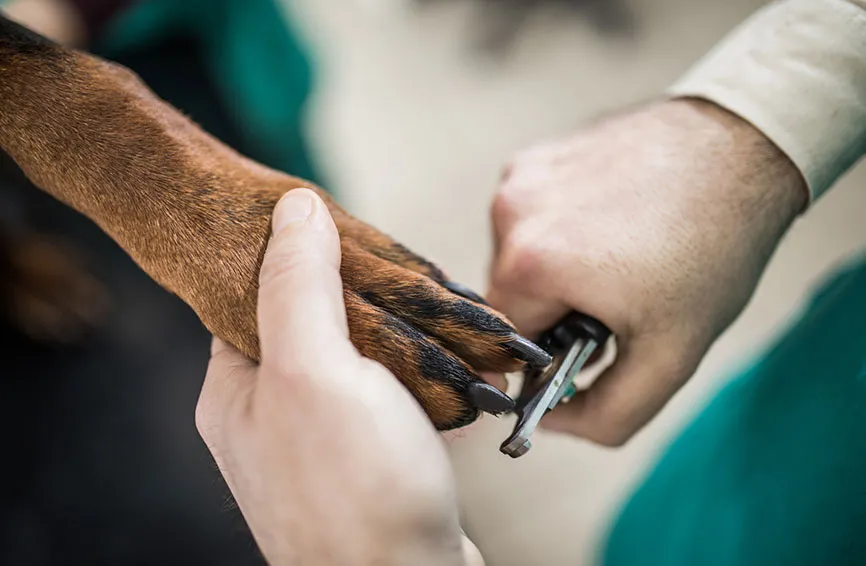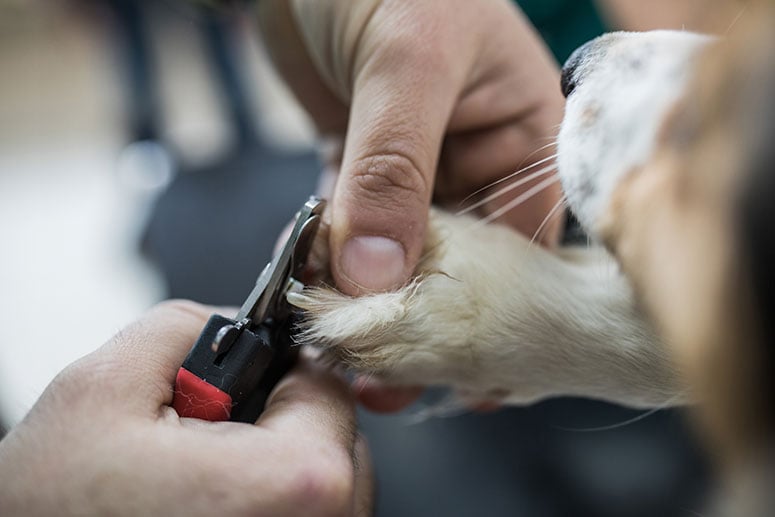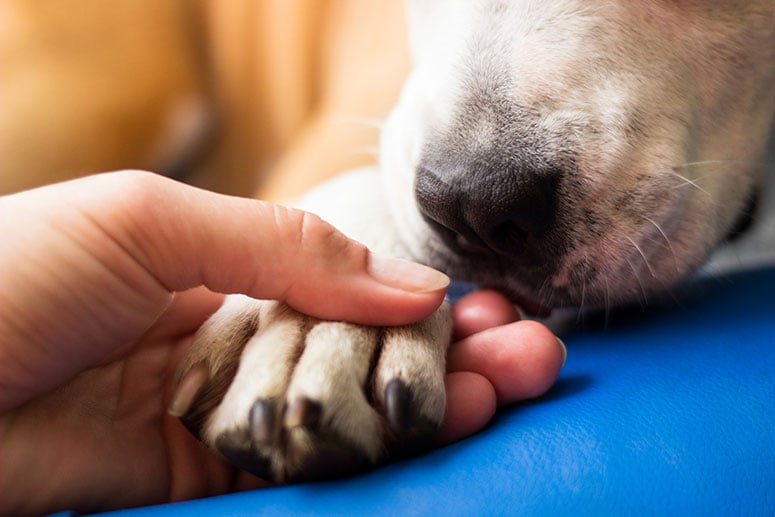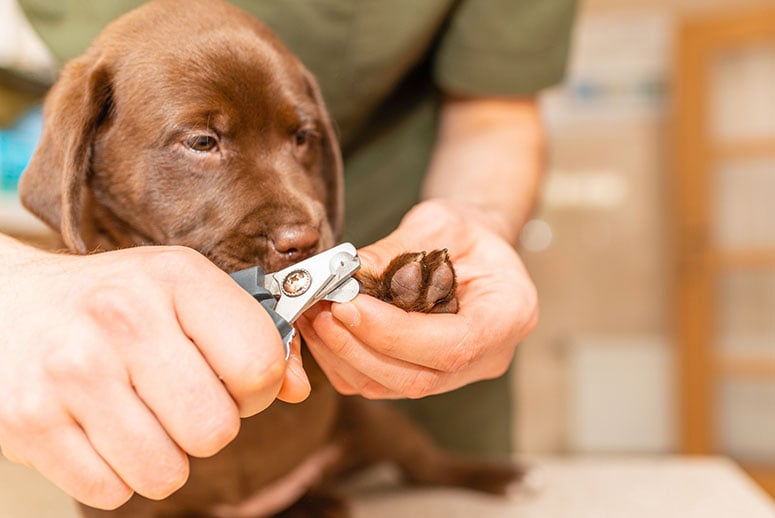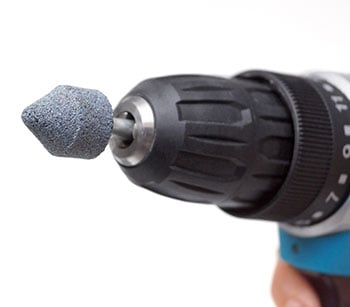Key Takeaways
- Trimming your dogs’ nails doesn’t have to be stressful for you or them, if you are patient and work up to it slowly.
- Trimming nails is an opportunity to bond and build trust with your dog.
- It’s essential to move slowly, taking weeks or even months to get your dog comfortable with having their feet touched, and eventually, nails trimmed.
Table of Contents
Many dogs struggle with nail trimming and the experience can be stressful for you and your pup. With time and patience, you can teach your dog to be less fearful of having their nails trimmed. They will never love it but can learn to tolerate it, and you can improve your bond with your dog at the same time.
Why are many dogs afraid of having their nails trimmed?
- They have had dewclaws removed
If your dog has had their dewclaws removed, it can cause nail trimming issues. Imagine being taken into the back of a vet’s office with someone you don’t know or who has caused you discomfort, and suddenly your thumbs are cut off by something sharp. No wonder dogs are nervous and scared about having their feet touched after this trauma. - Inadequate handling in the past
If dogs aren’t handled enough when they are puppies and taught to feel safe having their feet and other body parts touched, it can feel uncomfortable and scary to them when you do touch their feet. If attempting to trim their nails at home with clippers and hold them while they pull their foot away, you are much more likely to cut the quick or sensitive part. If you accidentally cut the quick, it can lead to greater fear for your dog in the future. Also, holding them firmly as they squirm also creates more trauma for your dog and damages their level of trust in you. - No prior experience with nail trimming
Similarly, if you have a rescue dog used to living on the streets or the previous family didn’t trim their nails, it can be a huge ordeal for you to cut their nails. - Physical sensitivity
Dogs, just like people, have different levels of physical sensitivity. When dogs are more sensitive to their environment, energy, and emotions, they can also be susceptible to physical pain. In these cases, just touching their nails can cause a dog to feel stressed as they remember their last nail clipping experience.
Nail trimming at a vet’s office
Usually, asking your vet or groomer to trim their nails isn’t the best option, even though it may seem easier. Your dog is already likely to view the vet’s office as a stressful place; it smells weird, they hear other animals in distress, and nothing fun ever happens there.
The issues with a groomer are similar, especially if it’s someone they don’t already know. Even when they love people but are fearful of getting their nails trimmed or touched, any dog could bite even an experienced groomer.
So, if your dog is already feeling anxious about nail trimming or their vet visits, it could just contribute to their fear. Plus, the vets are on a schedule, and probably not able to take their time to approach the nail trimming as slowly as your dog needs, giving them time to recover between nails.
Some dogs may handle nail trimming at the vet or groomer just fine; like anything else, it’s important to consider your dog’s history, known fears, personality, and ability to cope in a potentially stressful situation.
Approach nail trimming as a bonding experience
Why not see this ‘challenge’ with your dog as an opportunity to create more trust and a deeper bond with them? Helping them overcome this fear and insecurity could take a few months and it’s essential to be patient, compassionate, and understanding with your dog as you help them. Know that their nails will probably be longer than you would like for a while, so walk them on a sidewalk to help wear down their nails naturally until you can trim them.
How to trim nails and build trust
What you’ll need:
- A spatula
- Nut butter (or something else that your dog loves that you can smear on the spatula)
- A nail trimmer
- A Dremel
Step 1 – Getting your dog used to you holding the nail trimmer
- Sit on the floor rather than kneeling (avoid looming over them).
- Put the nail trimmer on the ground near you.
- Smear some nut butter on the spatula.
- Call your dog to you.
- After your dog approaches, hold up the spatula for them to lick.
- Wait 20 seconds and then slowly reach towards the nail trimmer while your dog continues to lick the spatula.
- If your dog backs away, bring your hand back to your lap and call your dog back over to you and try reaching for the nail trimmer again.
- If your dog keeps licking the nut butter, hold the nail trimmer in your hand, but keep it at a distance and hold it close to the ground.
- After holding the nail trimmer for about 30 seconds, put it back on the ground.
- Give your dog a lot of praise for being brave as you touched the nail trimmer.
Perform these steps several times until your dog is comfortable approaching you, not cowering or stretching their legs to reach you. Once your dog is willing to stay close to you when you have the clippers in your lap, you can start touching their feet.
Step 2 – Touching your dog’s feet with the clippers nearby
- Ask your dog to give you their paw and touch the paw they feel most comfortable with you touching while you hold the trimmers in the other hand on your lap.
- Gently touch a finger to one of their nails, then end the training session.
Step 3 – Start touching the nails
- As in step 2, get your dog comfortable with you touching one nail, then move on to touching several nails.
- Gradually continue working this step until your dog feels comfortable with you touching your finger to each nail on every paw.
Step 4 – Touch the clippers to one nail
- After touching the nails with your finger as usual, slowly touch the clippers to one nail on the paw they are most comfortable with.
- End the session with more nut butter as a reward for being brave.
- Touch the clippers to just one nail on the same paw each day.
Step 5 – Touch the clippers to all nails
- Once they seem comfortable with you touching the clippers to one paw, move on to the next paw and repeat the process.
- Continue until you can touch the clippers to every nail on each paw.
Step 6 – Start trying to trim one nail
- Cutting just the tip, attempt to trim one nail, again on the paw they are most comfortable giving you.
- Ensure that you are exuding confidence, and are calm and relaxed.
- Trim one nail each day until you notice that your dog is feeling more comfortable during the experience.
Step 7- Trim more than one nail
- Begin trimming a couple nails in one session.
- Gradually increase the number of nails you trim as your dog’s comfort level becomes more evident.
Important things to consider:
Take baby steps
Don’t move to the next step until they are doing well with the step you are practicing.
The steps described may seem incremental, but it’s important to take small steps when dealing with a dog’s fear. If you try to rush the process or put any pressure on them, they won’t feel safe, and they won’t overcome their anxiety.
Get them used to having their feet touched by wiping them clean
You can help your dog’s feeling of trust and safety regarding you touching their feet by wiping off the paws every time they come inside from a walk or going potty. Put a mat just inside the door that you ask them to sit on, and then ask them to give you their paw. Keep it simple with one word as you pick up each paw. After you have wiped their paws give them a treat for co-operating and to give them more incentive and make it a good experience.
Have a second person help
If someone holds the spatula, facing away from what you are doing, it will help your dog to focus on something else for a second as you trim.
Use quiet nail clippers
Some clippers have a louder ‘snipping’ noise as they cut. This noise can cause panic for some dogs.
Ensure adequate lighting
It’s best to trim their nails near a window and during the daytime when lighting is best.
Always end on a good note
If your dog gets anxious during the process, stop attempting to touch the nails and end it on a good note by giving praise, affection, and nut butter.
Don’t rush
Allow plenty of time to trim their nails; never try to rush the experience or your dog will feel the pressure and it could contribute towards their feeling of stress.
Give a special treat immediately after trimming
Right after the trimming experience, give your dog a high-value reward, like a bully stick to chew on. By doing this, your dog will start to have another positive association with getting their nails trimmed.
Clippers vs. a Dremel
Every dog is unique, and some dogs feel more comfortable with a Dremel (a multipurpose tool with a grinder attachment) than clippers. If your dog is more sensitive to noise and touch, it’s more likely that the Dremel will be too much for them and you will need to stick with clippers.
If you are unsure about using a Dremel, see how your dog responds when you turn on a Dremel near them. If they cower or back up, stick with the clippers. However, if they just seem a bit nervous because they have never seen or heard a Dremel before, following the same steps could help them get comfortable with it.
The benefits of using a Dremel
Using clippers can leave a sharp point on the nail. If you want a softer edge you can touch up the end of the nail with the Dremel.
You can watch as the nail is filed and stop the Dremel before you touch the quick.
If your dog has thicker nails, the Dremel requires less pressure than a clipper to cut the nail.
Summary
The goal is to create a feeling of trust and safety for your dog. Even when your dog is comfortable with the process, it’s still not usually something dogs love, but tolerate. So, instead of doing all of their nails in one sitting, trim the nails of one paw at a time. The less time spent trimming their nails, the less of an ordeal it is for them. This continues to give your dog more good experiences and build their trust in you.
